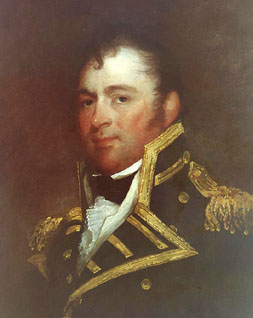| Isaac Chauncey  Born: 20-Feb-1772 Born: 20-Feb-1772
Birthplace: Black Rock, CT
Died: 27-Feb-1840
Location of death: Washington, DC
Cause of death: unspecified
Remains: Buried, Congressional Cemetery, Washington, DC
Gender: Male
Race or Ethnicity: White
Occupation: Military Nationality: United States
Executive summary: US Naval commander, War of 1812 Military service: US Navy (1798-1840) American naval commander, born at Black Rock, Connecticut, on the 20th of February 1772. He was brought up in the merchant service, and entered the United States Navy as a lieutenant in 1798. His first services were rendered against the Barbary pirates. During these operations, more especially at Tripoli, he greatly distinguished himself, and was voted by Congress a sword of honor, which, however, does not appear to have been given him. The most active period of his life is that of his command on the Lakes during the War of 1812. He took the command at Sackett's Harbor on Lake Ontario in October 1812. There was at that time only one American vessel, the brig "Oneida", and one armed prize, a schooner, on the lake. But Commodore Chauncey brought from 400 to 500 officers and men with him, and local resources for building being abundant, he had by November formed a squadron of ten vessels, with which he attacked the Canadian port, York, taking it in April 1813, capturing one vessel and causing the destruction of another then under construction. He returned to Sackett's Harbor. In May Sir James Lucas Yeo (1732-1818) came out from England with some 500 officers and men, to organize a squadron for service on the Lakes. By the end of the month he was ready for service with a squadron of eight ships and brigs, and some small craft. The governor, Sir G. Prevost, gave him no serious support. On the 29th of May, during Chauncey's absence at Niagara, the Americans were attacked at Sackett's Harbor and would have been defeated if Prevost had not insisted on a retreat at the very moment when the American shipbuilding yard was in danger of being burnt, with a ship of more than eight hundred tons on the stocks. The retreat of the British force gave Chauncey time to complete this vessel, the "General Pike", which was so far superior to anything under Yeo's command that she was said to be equal in effective strength to the whole of the British flotilla. The American commodore was considered by many of his subordinates to have displayed excessive caution. In August he skirmished with Sir James Yeo's small squadron of six vessels, but made little effective use of his own fourteen. Two of his schooners were upset in a squall, with the loss of all hands, and he allowed two to be cut off by Yeo. Commodore Chauncey showed a preference for relying on his long guns, and a disinclination to come to close quarters. He was described as chasing the British squadron all around the lake, but his encounters did not go beyond artillery duels at long range, and he allowed his enemy to continue in existence long after he might have been destroyed. The winter suspended operations, and both sides made exertions to increase their forces. The Americans had the advantage of commanding greater resources for shipbuilding. Sir James Yeo began by blockading Sackett's Harbor in the early part of 1814, but when the American squadron was ready he was compelled to retire by the disparity of the forces. The American commodore was now able to blockade the British flotilla at Kingston. When the cruising season of the lake was nearly over he in his turn retired to Sackett's Harbor, and did not leave it for the rest of the war. During his later years be served as commissioner of the navy, and was president of the board of naval commissioners from 1833 until his death at Washington on the 27th of February 1840.
Do you know something we don't?
Submit a correction or make a comment about this profile
Copyright ©2019 Soylent Communications
|